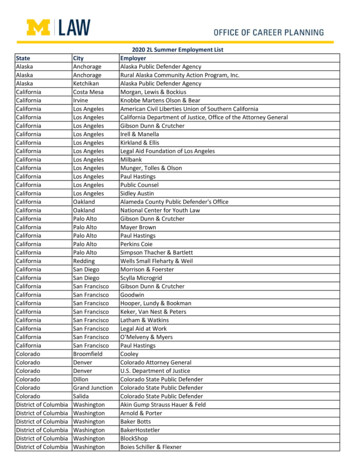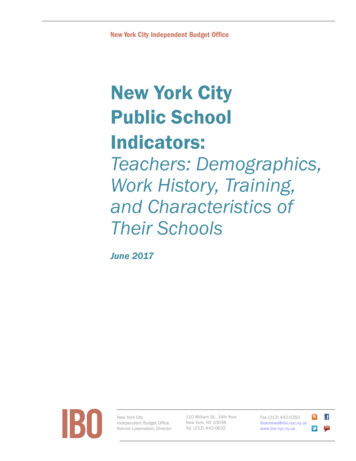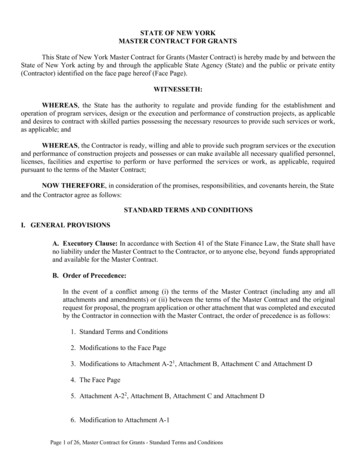
Transcription
New York State Office of Alcoholism and Substance Abuse Services2021 Local Services Plan - Broome Co Community Mental Health Srvs (70000)2021 Mental Hygiene Executive SummaryBroome Co Community Mental Health SrvsCertified: Emily Hotchkiss-Plowe (9/14/20)Broome County, bordered by Chenango, Cortland, Delaware and Tioga counties, is located in the Southern Tier of New York nearthe Pennsylvania border. With a total land area of 706 square miles, the county is central urban/suburban core. Binghamton, thecounty's most densely populated city, is located at the confluence of the Chenango and Susquehanna Rivers. It is surrounded byrural villages and towns including Johnson City, Vestal, Endicott, Endwell, Chenango Forks, Maine, Port Dickinson, Whitney Point,Windsor and others. Broome County has two major medical facilities, a State University, (Binghamton University), NYS SUNYBroome Community College, state psychiatric facility, and NYS Developmental Disabilities Regional Office. The county has aBOCES and 12 public school districts: Binghamton, Chenango Forks, Chenango Valley, Deposit, Harpursville, Johnson City,Maine-Endwell, Susquehanna Valley, Union-Endicott, Vestal, Whitney Point, and Windsor; as well as numerous private schools.Broome County has served as a Refugee Resettlement site for over 3000 Asian, Middle Eastern, African and Eastern Europeanrefugees since 1988. The diversity of this population is reflected in local schools; for example, Johnson City School District reportsthat 17 languages are represented in their middle school population alone. Due in part of the cultural diversity in this population,Broome County has made significant efforts to ensure cultural and linguistic competence in the provider community.Broome County Department of Mental Health is committed to serving all constituents in the need of behavioral health services byproviding the highest quality of care and compassion.AttachmentsBroome COVID19 Supplemental.pdf1
New York State Office of Alcoholism and Substance Abuse Services2021 Local Services Plan - Broome Co Community Mental Health Srvs (70000)Mental Hygiene Goals and Objectives FormBroome Co Community Mental Health Srvs (70000)Certified: Emily Hotchkiss-Plowe (9/11/20)1. Overall Needs Assessment by Population (Required)Please explain why or how the overall needs have changed and the results from those changes.The question below asks for an overall assessment of unmet needs; however certain individual unmet needs may diverge from overall needs.Please use the text boxes below to describe which (if any) specific needs have improved, worsened, or stayed the same.a) Indicate how the level of unmet mental health service needs, overall, has changed over the past year:WorsenedImprovedStayed the SamePlease describe any unmet mental health service needs that have improved:There are currently 7 licensed school-based mental health clinics in different school districts with imminent expansions in other districts. Thereare 3 family support centers in 3 different school districts. There are continued conversations for more licensed mental health school-basedclinics as well as family support centers. MHAST provides a Crisis Respite home offering 24/7 respite to eligible participants as well as the 24/7warmline to all.Outpatient clinics are quicker in processing referrals and admitting individuals. Family & Children's, UHS Adult, GBHC Children now have openaccess and the state outpatient treatment center has a much shorter wait for admission than years past.Individuals residing in the community can receive BH HCBS services as an extra support if they choose and are eligible.Peer services are becoming more prevalent in both the mental health and substance use areas as “lived experience” can offer the best educationand support to others.Please describe any unmet mental health service needs that have stayed the same:In regard to housing, there are few options for individuals who are just looking for housing and that don’t want to participate in a structuredprogram.There remains a large number of consumers who would benefit from/would be best served by an ACT Level of Care, but our current ACT teamdoes not have the capacity to accommodate. Likewise, appropriate mental health housing is difficult to access and/or find, the community is inneed of an SRO.Recommend that the county note how long it takes for individuals to be seen after they have an assessment to meeting with a prescriber.Recommend that the ASA and MH subcommittees combine a few meetings a year. There is not much information regarding referral processes toMH providers. We struggle with coordination of care with some MH providers.Please describe any unmet mental health service needs that have worsened:While the OMH Licensed Mental Health Clinics in Broome County do prioritize clients when they call, there are still waiting lists for childrenand adults.The mental health clients have more complex issues with co-occurring needs that makes collaboration for all (OMH, OASAS, OPWDD) servicesdifficult.The Opioid epdemic has contributed to the need for more services in mental health/substance use to address co-occurring clients.Safe, affordable housing continues to be a challenge for individuals that are not coming out of prisons or the state psychiatric centers, both whoare considered a priority to house. With the increase of student housing, sites in Binghamton are lessening and individuals are being pushed out toJohnson City and Endicott. Additionally, the cost of rent continues to rise making it more difficult to find affordable sites for individuals.b) Indicate how the level of unmet substance use disorder (SUD) needs, overall, has changed over the past year:SameImprovedStayed theWorsenedPlease describe any unmet SUD service needs that have improved:Although the opioid epidemic in Broome County has remained a serious issue, addiction treatment providers are working to meet the demand andare always looking at ways to expand services in a thoughtful manner.Broome County offers Addiction Family Navigator, Peer Advocacy services, Drug Free Communities Coordinator, and The Voices RecoveryCenter (opened October 2017). Helio Health opened the Binghamton Evaluation Center last April (2018) to provide medically supervisedwithdrawal and stabilization services (detox) adding Inpatient Rehabilitation in July 2019. In April 2019, Fairview transitioned its CommunityResidence Program to a 820 Residential Rehabilitation Program. The typical stay for the Residential Rehab is approximately 90 days. TheResidential Rehab provides treatment to 24 males and 18 females. Fairview still has 30 shelter plus care beds, 6 Medicaid redesign treatment bedsand 34 support living scattered site beds, and the Addiction Stabilization Center has 20 beds.The Broome Opioid Awareness Council (BOAC) has over 50 members and meets monthly and/or bimonthly to address needs within thecommunity.Local providers have been coordinated services with all law enforcement agencies in an effort to intervene at the earliest possible moment. PeerAdvocates work closely with law enforcment and emergency services personnel to reach out to people who have overdosed in order to engagethem in treatment services. Also the Broome County Sheriff has a program, Sheriff Assisted Recovery Initiative (SARI) where someone can callthe Sheriff's department and receive assistance in immediately accessing SUD services throught the Addiction Stabilization Center or UHSextended observation beds.1
New York State Office of Alcoholism and Substance Abuse Services2021 Local Services Plan - Broome Co Community Mental Health Srvs (70000)ACBC offers Medication Assisted Treatment (MAT) with vivitrol as well as monthly injections as needed. They offer MAT with Suboxone,currently seeing many clients with varying visits. The Center for Treatment Innovation (COTI) staff include peers that outreach and take clientshopping, etc. The COTI team performs assessments and holds groups at the Jail. Primary substances that ACBC clients have are: alcohol,marijuana and opioids. ACBC has adolescent services and groups at the Children's Home with currently around 20 youth.Additional services and programs have come on board in 2019, including the following:The Jail Cognitive Behavioral Program, operated by the Southern Tier AIDS Program, Inc., at the Broome County Correctional Facilitystarted in January of 2019. The goals of the program are to assist with rehabilitation prior to release and transition discharge planning forindividuals returning to the community.On July 22, 2019, Helio Health received certification to convert 20 of the 50 medically supervised beds for withdrawal to swing bedsthat would allow for Inpatient Rehabilitation should that level of care not be available elsewhere.Broome County was one of 15 New York counties selected to participate in the National Institute on Drug Abuse – Helping to EndAddiction Long-term (NIDA-HEAL) grant awarded to Columbia University which aims to reduce the Opioid overdose rate by 40percent over a 4-year funding cycle.Addiction Center of Broome County filled the Dual Recovery Coordinator position at the end of 2019.Addiction Center of Broome County opened a second location, The Center for Addiction and Trauma Recovery, in Endicott, NY on July25, 2019.Sunrise Center at CHOWC opened in the Fall of 2018.United Health Services (UHS) began implementing a Jail Substance Use Disorder program in Broome County in 2019 which includesMedication Assisted Treatment (MAT) at the jail, transition to outpatient providers upon discharge, detox services for anyone at the jail,and maintenance services for sentenced individuals.OASAS funded the coalition with one-time money to initiate prevention initiatives specifically in the SOR/ESPRI community ofBinghamton. This has led to a special work group that engaged a new set of stakeholders within the community.The Lourdes Opioid Use Disorder (OUD) Cohort Management Project is a collaboration between Our Lady of Lourdes MemorialHospital, Inc.; REACH Medical, PLLC.; Truth Pharm, Inc.; Southern Tier Aids Program, Inc.; Rural Health Network of South CentralNew York, Inc.; and The Addiction Center of Broome County, Inc. In January 2019 the OUD Cohort began enrollments and throughMarch 2020 has supported 309 persons through care coordination and support in an effort to increase patient engagement with primarycare providers, increase address social determinants of health and access to community resources. Through this support and carecoordination the goal has been to promote interest in and engagement with treatment.Please describe any unmet SUD service needs that have stayed the same:Please describe any unmet SUD service needs that have worsened:Providers are seeing more multiple diagnosed clients with SUD, Mental Health and a developmental disability. The dually-diagnosed populationseems to be growing, yet there does not seem to have been a growth in dual diagnosis programs in the area to serve/mitigate the demand in regardto outpatient treatment and specialized housing.Providers have noted an increase in the number of admissions for methamphetamine usage. According to OASAS Apps, Broome County saw an86% increase in Methamphetamine as the Primary Substance for admission from 257 in 2018 to 480 in 2019. There is a gap in care forindividuals with methamphetamine use disorders. They often will not meet admission criteria for inpatient detoxification or inpatientrehabilitation. They are at risk for overdose due to cross contamination of fentanyl. Individuals struggling with methamphetamine use disordercan present with psychosis and are not eligible for care at CPEP or inpatient psychiatry but are not stable to have their needs met in outpatienttreatment. There are no FDA approved medications for methamphetamine use disorders. There is a need for a community protocol and bestpractices for care planning because we now have another population that will fall through the cracks.c) Indicate how the level of unmet needs of the developmentally disabled population, overall, has changed in the past year:Stayed the SameImprovedWorsenedPlease describe any unmet developmentally disability service needs that have improved:Care Coordination has improved for adults and children. We have noted some improvements in the process with the introduction of CareCoordination. One such improvement is in regards to Health Home Care Management, which no longer has a wait list allowing consumers toreceive assistance in a shorter time frame. Additionally, Care Connections is available to assist with gathering documents and helping with theeligibility process, making it smoother.Please describe any unmet developmentally disability service needs that have stayed the same:Respite services – in-home and site basedCommunity habilitation services, and employment opportunitiesCrisis services including intensive behavioral supportsClinical services – medication management, counseling, OT, PT, Speech, Dental, mental healthPlease describe any unmet developmentally disability service needs that have worsened:Broome County has identified a number of critical shortages in terms of services for individuals with developmental disabilities including thefollowing:Workforce recruitment and retentionEarly InterventionPreschoolAll three of the above areas have continually been of concern in this area. Shortages in providers to serve Early Intervention and Preschoolchildren create long wait lists and difficulty receiving services. Community Habilitation needs are still very apparent as more providers areneeded. There is also a need for respite services for individuals at this time.There are simply not enough individuals willing to provide these services to the developmentally disabled citizens of Broome County. Lowwages, and the part-time and variable nature of the work hours/work schedule compound the difficulty in finding qualified providers.2
New York State Office of Alcoholism and Substance Abuse Services2021 Local Services Plan - Broome Co Community Mental Health Srvs (70000)In some areas improvement has been noted including the front door process, self directed search amd variety of residential options.The second section of the form includes; goals based on local need; goals based on state initiatives and goals based in other areas. The formallows counties to identify forward looking, change-oriented goals that respond to and are based on local needs and are consistent with the goalsof the state mental hygiene agencies. County needs and goals also inform the statewide comprehensive planning efforts of the three state agenciesand help to shape policy, programming, and funding decisions. For county needs assessments, goals and objectives to be most effective, theyneed to be clear, focused and achievable. The following instructions promote a convention for developing and writing effective goal statementsand actionable objectives based on needs, state or regional initiatives or other relevant areas.2. Goals Based On Local NeedsIssue CategoryApplicable StateAgenc(ies)OASAS OMH OPWDDa) Housingb) Transportationc) Crisis Servicesd) Workforce Recruitment and Retention (service system)e) Employment/ Job Opportunities (clients)f) Preventiong) Inpatient Treatment Servicesh) Recovery and Support Servicesi) Reducing Stigmaj) SUD Outpatient Servicesk) SUD Residential Treatment Servicesl) Heroin and Opioid Programs and Servicesm) Coordination/Integration with Other Systems for SUD clientsn) Mental Health Clinico) Other Mental Health Outpatient Services (non-clinic)p) Mental Health Care Coordinationq) Developmental Disability Clinical Servicesr) Developmental Disability Children Servicess) Developmental Disability Student/Transition Servicest) Developmental Disability Respite Servicesu) Developmental Disability Family Supportsv) Developmental Disability Self-Directed Servicesw) Autism Servicesx) Developmental Disability Front Doory) Developmental Disability Care Coordinationz) Other Need 1(Specify in Background Information)aa) Other Need 2 (Specify in Background Information)ab) Problem Gamblingac) Adverse Childhood Experiences (ACEs)(After a need issue category is selected, related follow-up questions will display below the table)2a. Housing - Background InformationSafe affordable housing for OMH, OASAS and OPWDD clients is badly needed in Broome County. Housing is a constant issue every year. Newhousing in the community is generally created for students at Binghamton University and not accessible for our vulnerable populations. HUD isin the process of major changes in some of its housing policies and the community is still attempting to figure out how this will impact theremaining HUD funded housing services. Binghamton Mayor Rich David has announced his administration will pursue creating 50 new beds forvulnerable populations.Sober living housing is needed for people who are recovering from addiction. They typically operate like group homes that are free of alcoholand drugs for individuals in recovery.There has been a lot of development but huge need remains for OPWDD. More options are needed for individuals to transition to moreindependent settings. If more opportunities were available for individuals presently living in IRA's for example, to transition to more independent3
New York State Office of Alcoholism and Substance Abuse Services2021 Local Services Plan - Broome Co Community Mental Health Srvs (70000)settings, there would be more opportunities for others, who may need this level of support to back fill those slots.Springbrook’s Century Sunrise Integrated Supported Housing (ISH) project in Johnson City continues to thrive, adding six units totaling 32 unitsdedicated to people receiving OPWDD services. This model uses Self-Directed Services (SDS), which offers housing subsidies, CommunityHabilitation, Respite, and Supported Employment, and funding for things like community classes and Paid-Neighbors. The use of SDS in this wayis not limited to ISH projects; rather any residential situation is eligible for SDS. Springbrook’s Master Housing Navigator can help to designservices in this way – see these two links for details: https://nyhrc.org/index.php and https://youtu.be/rK84bccWCIwThe Homeless Coalition’s Continuum of Care Committee conducts a HUD prescribed Point in Time (PIT) count annually during the last week inJanuary. The PIT is done over a 24-hour period and aims to collect statistically reliable, unduplicated counts or estimates of homeless persons insheltered and unsheltered locations at a one-day point in time. Chronic homelessness is one of the several homeless subpopulations tracked in thePIT. Substance Abuse is a significant factor contributing to chronic homelessness and as such, Fairview Recovery Services continues to expandthe implementation of the HUD funded Homeless Management Information System, Shelter-Net. All the initial targeted emergency, transitionaland permanent supportive beds are currently online. HMIS provides the fastest and most accurate census of Broome County’s homelesspopulation. Through a HUD grant, Coordinated Entry System was established in June 2017 which creates a "no wrong door" approach forhomeless individuals and families in need of housing. The Homeless Coalition was incorporated into a 501c3 agency in 2009. Communitystakeholders and key partners actively participate in the Homeless Coalition. Their participation and collaboration within the Continuum of Careprovides insight into the underlying causes of homelessness such as CD, MH, DD (It would make more sense to spell these out since the personwho reads this may not be familiar with the abbreviations). Homelessness in Broome County impacts all the agencies that work together to affectplanning for client care, thus the community agencies are committed to the Coalition and having a positive impact on the homeless population.Do you have a Goal related to addressing this need?YesNoGoal Statement- Is this Goal a priority goal (Maximum 5 Objectives per goal)?YesNoAdvocate for all types of safe and affordable housing possibilities in all areas of the residential continuum for individuals with all disabilities.Objective StatementObjective 1: The CSB Subcommittees, agency provider workgroups and other stakeholders will explore innovative housing options that are beingutilized in other communities to plan for future options including grassroots local organizations that are looking to house individuals with BHdisorders. Continue to consider necessary funding and needed supports.Applicable State Agency: (check all that apply):OASASOMHOPWDDObjective 2: Advocate for additional respite opportunities both planned and especially emergency for individuals with disabilitiesApplicable State Agency: (check all that apply):OASASOMHOPWDDChange Over Past 12 Months (Optional)MHAST runs a 6 bed Crisis Respite in March 2018 to serve eligible particpants needing short-term respite services as a a diversion fromhospitalization.The new Binghamton University Pharmacy School has opened in JC, student housing needed in that area may likely push out affordable familyhousing. The community needs to balance the needs of all individuals to offering affordable housing.With OPWDD services, there has been a lot of development but huge need remains. Development in recent years has been focused solelyaddressing the needs of individuals leaving the developmental center due to its closure and the aging out population, especially students leavingresidential schools. More options are needed for individuals to transition to more independent options. Presently, there are no incentives to moveindividuals from their present residential setting, even if they might be interested in a move to another setting. If more opportunities wereavailable for individuals presently living in IRA’s for example, to transition to more independent settings, there would be more opportunities forothers, who may need this level of support to back fill those slots.The annual RFP has gone out for residential development for individuals aging out of residential schools. Achieve has been awarded funding todevelop a 2-bed VOIRA during the 2018-2019 plan year. Development in 2017-2018 plan year includes: Responding to an RFP addressing theSubstantial and Current Residential Needs List, Community Options has developed a 4-bed VOIRA and in February, 2018 Springbrook opened a5-bed VOIRA for individuals aging-out of residential schools. The Emergency and Substantial Need List Community Options is in the process ofdeveloping a 4-bed VOIRA.A community partnership is making 26 apartments in a new complex of 106 apartments in Johnson City available to individuals with IntellecturalDisabilities who have been determined to be eligible for OPWDD services. The individuals residing in these 26 non-certified apartments will beeligible to receive support services from Springbrook. Springbrook will be the oversight agency attached to the property. The Southern TierIndependence Center (STIC) partnered with the First Ward Action Council to provide support to individuals with Intellectual Disabilities. STICwill provide the supports for the individuals living in the 5 apartments. STIC will be the oversight agency for the project for the individualsidentified for the 5 apartments supported by OPWDD.2b. Transportation - Background InformationThere is limited public transportation in Broome County and no public transportation in some communities. Limited public transportation routesand schedules has proved to be an impediment for many in the community, preventing people from accessing employment and other opportunitiesto participate more fully in the community. Because of the limited public transportation available in our community, individuals have fewerchoices regarding where they can live, work and socialize. Additionally, the bus system is complicated to learn and cumbersome to utilize. Also,only a portion of the population qualifies for Medicaid funded transportation services.Frequently there are delays in obtaining transportation services through Medicaid Answering Service (MAS - transportation for Medicaidbeneficiaries to and from medical services) for patients with urgent needs and for those who require regular use of taxi cabs. The process toarrange transportation through MAS is somewhat cumbersome and consumes a significant amount of staff resources at the program level tocoordinate. The time staff are spending trying to coordinate transportation services is time that they are not available to provide direct clinicalservices.4
New York State Office of Alcoholism and Substance Abuse Services2021 Local Services Plan - Broome Co Community Mental Health Srvs (70000)Do you have a Goal related to addressing this need?YesNoIf "No", Please discuss any challenges that have precluded the development of a goal (e.g. external barriers):This is an ongoing issue that seems to be difficult to resolve, however, it is a discussion point on various agendas for community meetings.Change Over Past 12 Months (Optional)Rural Health Network has implemented a program called "Get There" for health care transportation covering both Medicaid and non-medicaidservices. In addition, Getthere offers a voucher program to eligible recipents to meet other transportation needs.Much of Broome County is rural and public transportation options and routes are limited. This continues to be a barrier which preventsindividuals with Intellectual Disabilities from being able to participate as fully in the community as would be optimal.2c. Crisis Services - Background InformationThrough the DSRIP initiative, we secured a Mobile Crisis Services unit through the Mental Health Association that works with the police onidentifying consumers in need of services. The Crisis Intervention Worker and 2 Social Workers are training law enforcement agencies in thecommunity as well as doing ride-alongs with police when necessary to assist with persons with emotional disturbances who are in some kind ofaltercation requiring police intervention. Additonally, Brooome County recently implemented a 911 Diversion program in which people who call911 in crisis are screened and if appopriate, the call is diverted to the CPEP hotline where a worker will determine next steps. The hope is todivert officers from being immediately dispatched prior to accessing the acuity of the crisis. MHAST runs a 6 bed Crisis Respite residence.The Addiction Stabilization Center (ASC) has one bed that is dedicated to the Sheriff’s Assisted Recovery Initiative (SARI) Program whichallows people in need of stabilization from drug use to access a bed at the ASC more easily with the help of the BC Sheriff. In the event that theASC has all beds filled, the SARI program brings patients to the emergency department at BGH where they will be evaluated and connecteddirectly to treatment services.Helio Health Binghamton Evaluation Center opened its doors in April 2018 offering medically supervised withdrawal and stabilization services(detox) and in July 2019, added inpatient rehabilitation. Helio Health will transport patients from the hospital or home to their facility.There is huge need in the community for crisis services for both children and adults. There are virtually no crisis services available in ourcommunity to serve individuals with developmental disabilities. PWDD does not provide this service, and CPEP frequently considers episodes ofindividuals presenting with developmental disabilities as “behavioral”. The lack of crisis services has resulted in individuals with developmentaldisabilities being inappropriately housed in mental health facilities or our county jail. The severity of this situation continues to increase. Patientsare often subjected to very long emergency department stays or frequent visits with discharge back to the group home they came from. This isvery stressful for the patient and teams at both the OPWDD facility and the hospital. There simply is no emergent response capability for personsserved by OPWDD.Given the conversion of Fairview Addiction Crisis Center into the ASC, Broome County no longer has any form of wet or damp shelter. The lossof that specialized level of care in the community has resulted in higher pressure in the emergency departments as patients are brought in on 22.09status to get them off the street. Some also present on their own to the emergency rooms seeking shelter when impaired. This unintendedconsequence of the OASAS residential redesign has created a situation where very expensive emergency department resources are consumed fora social crisis that is not a medical emergency. The community needs to have a wet or damp shelter facility that can receive these patients, provideshelter, assessment and referral to treatment when patients are willing to accept that referral.More training is needed for first responders particularly for law enforcement in regard to deescalate techniques. And more intensive behavioralsupports are needed. A crisis residence would go a long way in helping individuals deescalate and stabilize while avoiding the trauma and cost ofan inappropriate psychiatric admission or incarceration.Do you have a Goal related to addressing this need?YesNoIf "No", Please discuss any challenges that have precluded the development of a goal (e.g. external barriers):This issue is addressed under various other goals in the Plan.Change Over Past 12 Months (Optional)Narcan training is offered consistently and Narcan is being deployed regularly, saving lives. ACBC acquired additional funding to continueto improve access to services: including the family navigator/peer advocate program, intensive case manager, while waiting for treatment, peerintervention etc. for programs in Broome County. ACBC expanded their services in Endicott, NY opening The Center for
New York State Office of Alcoholism and Substance Abuse Services 2021 Local Services Plan - Broome Co Community Mental Health Srvs (70000) Mental Hygiene Goals and Objectives Form Broome Co Community Mental Health Srvs (70000) Certified: Emily Hotchkiss-Plowe (9/11/20) . access and the state outpatient treatment center has a much shorter wait .











